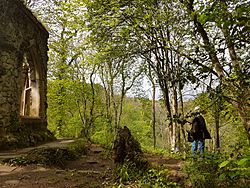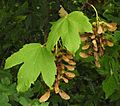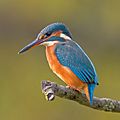Hack Fall Wood facts for kids
| Site of Special Scientific Interest | |

Fisher's Hall folly in Hack Fall Wood
|
|
| Area of Search | North Yorkshire |
|---|---|
| Coordinates | 54°11′20″N 1°38′20″W / 54.1890°N 1.6388°W |
| Interest | Biological |
| Area | 44.8687 hectares (0.4487 km2; 0.1732 sq mi) |
| Notification | 6 October 1989 |
| Location map | Magic Map (Defra) |
Hack Fall Wood, also known as Hackfall, is a special place in North Yorkshire, England. It's called a Site of Special Scientific Interest (SSSI). This means it's protected because of its amazing nature. The wood covers about 44.8687 hectares (0.4487 km2; 0.1732 sq mi) of land. It lies north-east of the village of Grewelthorpe.
Back in the 18th century, a rich landowner named William Aislabie shaped the wood. He made it look like a beautiful painting, with streams, pools, and even fake ruins called follies. Famous artists like Turner painted Hackfall. Pictures of it were even on a special dinner set for Catherine the Great! People in the 19th century thought it was "one of the most beautiful woods in the country."
In the 20th century, most of the trees were cut down. But the wood grew back naturally. In 1989, the Woodland Trust bought Hackfall. It was made an SSSI in the same year. The Woodland Trust, along with the Hackfall Trust and the Landmark Trust, worked hard to fix the paths and protect the old follies. They also helped the wildlife habitat grow strong again.
Hackfall Wood is home to lots of different animals and plants. You can find many birds, animals, and wildflowers here. There are also over 200 types of liverworts and mosses. Two very rare creatures live here too: a beetle called Platycis minutus and the lemon slug. This slug only lives in very old woodlands. Today, Hackfall is a protected Conservation Area and an Ancient Semi-Natural Woodland. You can visit the wood, and there's a car park for visitors.
Contents
A Look Back: Hack Fall Wood's Story
There are signs that people lived in this area a very long time ago. You can find old earth mounds from prehistoric times. A place called Camp Hill might have been a Roman camp. The name Grewelthorpe suggests that Danish people settled here. The name Hackfall itself might come from an old word for cutting trees and the sound of water falling through the gorge.
Hack Fall Wood is a very important Historic Garden, ranked Grade I. This means it's a special historical site. The old follies (decorative buildings) you can see are Mowbray Point Ruin, Mowbray Castle, the Rustic Temple, and Fisher's Hall. Fisher's Hall was built in 1750 and is named after William Aislabie's gardener.
Exploring the Follies
How the Landscape Was Shaped
Centuries ago, this area was simply known as Hackfall. John Aislabie (1670–1742) bought the land in 1731. He was known for designing the formal gardens at Studley Royal. He bought Hackfall for its timber and other resources like its lime kiln and coal pits.
His son, William Aislabie (1700–1781), had a different idea. He wanted to create a natural, beautiful landscape. He added follies, a fake waterfall, temples, and grottoes among the trees. These designs created lovely views and open spaces called glades. Aislabie used the Banqueting House (now Mowbray Point Ruin) to entertain his friends. Later, in the 19th century, it became a tea room for visitors. Mowbray Point might have been designed by a famous architect, Robert Adam. Today, it's a holiday cottage managed by the Landmark Trust.
Writers in the 19th century called Hackfall "one of the most beautiful woodlands in the country." Artists like J. M. W. Turner painted scenes from here. Hackfall is even mentioned in books by famous writers like William Wordsworth. It was also pictured on special Wedgwood dinnerware made for Catherine the Great in 1773.
Hackfall Before the Trees Were Cut
-
Hackfall by J. M. W. Turner, 1816
When Many Trees Were Felled
In March 1933, a timber merchant named John Green bought Hackfall. This happened after the National Trust couldn't buy it because they didn't have enough money. Most of the wood was then clear-felled, meaning almost all the trees were cut down. Some areas were replanted with conifer trees.
By 1937, Hackfall was used as a farm and for commercial wood. During World War II, it was left alone and sadly suffered from vandalism. Many features were lost in the 1930s and 1940s. These included cascades, weirs, benches, and small buildings like summerhouses. However, the wood was allowed to grow back naturally until the 1980s. A small part of the Sandbed Hut and the entrance Gate Pillars still remain today.
Bringing Hackfall Back to Life
In 1987, Hackfall was put up for sale again. There was a worry that it would be developed for businesses. So, the Hackfall Trust was created to raise money to restore the beautiful landscape. In 1989, the Woodland Trust bought the land. They promised to care for it for 999 years! They worked to fix the footpaths and woodland walks. They also protected the old follies and managed the delicate wildlife areas.
In 2007, the National Lottery Heritage Fund gave almost £1,000,000 to the Woodland Trust for this restoration. Other groups like Yorventure and Nidderdale Area of Outstanding Natural Beauty also helped with funding. The Hackfall Trust, the Woodland Trust, and the Landmark Trust are still in charge of keeping the site beautiful. The Landscape Agency did the actual work and even won an award for it in 2008. A warden was hired in 2009 to look after the wood.
Hack Fall Wood After Its Rebirth
-
River Ure view, 2014
Where Hack Fall Wood Is and Why It's Special
Hack Fall Wood is a 44.8687 hectares (0.4487 km2; 0.1732 sq mi) biological Site of Special Scientific Interest (SSSI). It's protected because it's a great example of an "ancient semi-natural broadleaved woodland." This means it's a very old forest that has grown mostly on its own. It has many different plants because of the varied rocks and soil underneath.
Hack Fall Wood is also listed as a Conservation Area. It's part of a plan to protect important wildlife, called the United Kingdom Biodiversity Action Plan. It's known as Ancient Semi-Natural Woodland (ASNW). It's also on the Invertebrate Site Register, meaning it's important for insects and other small creatures.
The wood sits on the north and east slopes of the Hackfall Gorge, where the River Ure flows. It's next to Grewelthorpe and south of Masham. There are four ways to enter the site. Even though there are no toilets or shops (the closest are in Grewelthorpe or Masham), it's been a popular place for visitors since the 19th century. Because of the rough ground and steep paths, it's not suitable for wheelchairs.
Amazing Plants and Animals
Flora: The Plant Life of Hackfall
Even though most of this ancient woodland was cut down in the 1930s, the trees you see now have grown back naturally. You'll find many different kinds of plants here. Some common ones include sycamore, beech, scots pine, foxglove, dog rose, and red campion. In spring, Hack Fall Wood is famous for its beautiful carpet of bluebells.
The types of plants growing here depend on the rocks and soil beneath them. For example, near the Brimham Grits cliffs, the soil is acidic. Here, you'll find trees like holly and rowan. The main trees are silver birch and sessile oak. On the ground, you might see small cow-wheat, hard fern, heather, bilberry, wavy hair-grass, and great wood-rush.
On the less steep slopes, the soil is less acidic. Here, you can find "uncommon" plants like herb Paris and toothwort. Other plants on the woodland floor include primrose, wood anemone, enchanter's nightshade, woodruff (or sweet-scented bedstraw), ramsons (wild garlic), and dog's mercury. These plants are typical of old, well-established woodlands. Above them, you'll see guelder rose and hazel. The tallest trees here are sycamore, wych elm, and ash. In spring, look for lesser celandine, early dog violet, opposite-leaved golden-saxifrage, and wood sorrel.
Hackfall has many pools and streams. These are fed by calcareous springs, which create wet, marshy areas. In these wet spots, you'll find tufted hair-grass, pendulous sedge, great horsetail, and meadowsweet. Above them grow spindle, bird cherry, and alder. Beside the streams and on rocks, there are many bryophytes (mosses and liverworts) and ferns. These include male fern, polypody, and hart's tongue.
In the northern part of the wood, many wych elms have been lost to Dutch elm disease. This has created open areas filled with rose bay willowherb, bramble, and bracken. The southern end is special because it has wood fescue (festuca altissima). This plant is very rare in Great Britain and grows on the cliff faces above the River Ure. Nearby, you'll also find many small-leaved lime trees. Some of these have grown back from trees planted in the 18th century.
Fauna: The Animal Life of Hackfall
Hackfall Wood is home to a wide variety of birds. By the river, you might spot a common sandpiper, grey wagtail, dipper, kingfisher, or even an osprey. In the woods, look for lesser spotted woodpecker, green woodpecker, great spotted woodpecker, wood warbler, nuthatch, chiffchaff, treecreeper, and buzzard. In March 2017, naturalists recorded 24 bird species here. These included mallard, sparrowhawk, grey wagtail, wren, robin, song thrush, blackbird, chiffchaff, great tit, long-tailed tit, nuthatch, and chaffinch.
Animals seen here include stoats, badgers, red foxes, brown hares, rabbits, grey squirrels, moles, roe deer, and otters. You might also see noctule bats and pipistrelle bats. Common frogs gather at the Fountain Pond during their breeding season. Palmate newts, smooth newts, and common toads have also been spotted here.
Bryophytes: Liverworts and Mosses
Over 202 types of liverworts and mosses have been found in Hackfall. In March 2017, naturalists recorded 24 different bryophytes. These included Pseudotaxiphyllum elegans, Orthotrichum pulchellum, Thamnobryum alopecurum, Mnium hornum, Eurhynchium striatum, and Orthotrichum affine.
Other Biota: Insects and Slugs
You can find various butterflies here, such as the speckled wood, orange tip, and peacock. Two very special creatures recorded here are the "locally rare" beetle (Platycis minutus) and the lemon slug. The lemon slug is a creature that lives in ancient woodlands and eats fungi. It has become rare because its natural home has been lost.
How Hack Fall Wood is Cared For
The main goal of caring for Hack Fall Wood is to make sure it stays healthy. This means the woodland should fit its history, geology, and geography. It also needs to keep growing back naturally after the trees were cut down in the 1930s. The protected habitat and all the living things (biota) in it need to be supported. This means having a mix of old and young trees, and some mature trees with a thick understorey (bushes and smaller plants).
Dead wood is important for fungi and invertebrates (like insects). However, since Hackfall is open to the public, dying trees must be made safe, especially in popular areas. Insects and butterflies benefit from occasional small, open areas called clearings. Creating these might involve cutting or coppicing (cutting trees to the base) some trees. Between August and February (to avoid bird breeding season), trees and shrubs that aren't native to the area might be removed. Some areas might be thinned to keep the woodland varied.
It's best for new trees to grow from old stumps or from seeds that fall naturally. This helps all the woodland life. Light grazing by deer, cattle, and rabbits can help keep different plant species growing. But sometimes, the wood needs protection if these animals eat too much. Invasive plants like Himalayan balsam and rhododendron are controlled. This helps protect the natural woodland. Some parts of the wood are left completely untouched. Fallen trees are allowed to pile up, creating homes and food for many different animals and insects.
Around the calcareous tufa springs, there are special plants. These plants need the minerals from the springs. The springs themselves need protection from anything that might harm the water source (aquifer) below. So, the site must be protected from things like commercial water extraction or pollution from waste, fertiliser, herbicides, and insecticides.



























































